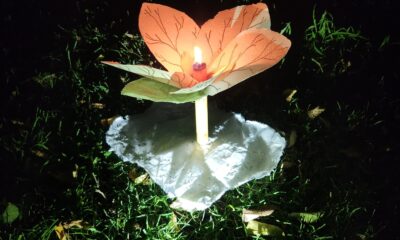Science
Researchers Unveil Blueprint for Spacetime Crystals Using Knotted Light

Researchers from Singapore and Japan have made a significant advancement in the realm of photonics and quantum technologies by developing a blueprint for spacetime crystals composed of knotted light structures called hopfions. This innovative work combines complex topological patterns with periodic repetition in both space and time, opening new possibilities for ultra-secure data storage and enhanced optical computing.
By employing two-color laser beams, the team has demonstrated a method to assemble these unique light knots into organized lattices. This marks a notable progression from isolated topological structures to more structured, repeatable systems. The concept is grounded in years of theoretical exploration in topological physics, where light fields are manipulated to create stable, knot-like configurations that resist decay.
Hopfions, named after mathematician Heinz Hopf, represent three-dimensional textures featuring interlinked internal spin patterns, resembling mathematical knots in higher dimensions. Previously, such structures had been primarily observed in isolation within magnetic materials or simple light fields. The researchers’ new approach integrates these structures into crystalline arrays that evolve periodically over time.
Unlocking the Potential of Tunable Topology
The incorporation of a temporal dimension elevates these creations to the status of “spacetime crystals,” a term that may sound fictional but is firmly rooted in quantum optics. As detailed in a report from ScienceDaily, the researchers exploit the interference of two laser beams at different wavelengths to create these ordered chains and lattices. The tunable nature of this topology allows for precise control over the knots’ linking numbers, facilitating dynamic reconfiguration in real-time applications.
Industry experts believe this breakthrough could revolutionize communications, where robust, interference-resistant signals are essential. For example, in photonic processing, these crystals might enable error-free data transmission by encoding information in the knots’ stable structures, drastically improving upon current fiber-optic technology.
This collaborative effort among institutions from Singapore and Japan illustrates a growing trend in international research, bridging theoretical topology with practical engineering applications.
From Isolated Knots to Periodic Wonders
The methodology involves structuring light beams to create hopfion lattices that repeat not only spatially, like atoms in traditional crystals, but also temporally, forming a four-dimensional framework. Insights shared on Slashdot indicate that this periodicity challenges conventional thermodynamic constraints, echoing earlier experiments with time crystals that maintain entropy in looping states.
The technique employing two-color beams is crucial: one beam establishes the foundational field, while the other induces the knotting, resulting in stable, self-sustaining patterns. Historical parallels exist, notably the 2017 creation of time crystals reported in ScienceDaily, where atomic structures repeated in time without energy input. However, this latest approach with light-based hopfions introduces a photonic twist, potentially scalable for room-temperature operations, unlike many quantum systems that require extreme cooling.
The implications of these spacetime crystals extend beyond theoretical constructs. They could facilitate dense information storage, where each hopfion knot holds multiple bits encoded in its topology and remains resistant to electromagnetic interference. As examined in a piece from Lifeboat News, this advancement might transform secure communications, providing tamper-proof channels for sensitive data in sectors such as finance and defense.
Moreover, the tunable characteristic opens avenues for adaptive photonic devices, including reconfigurable lasers or sensors that can adjust in real time. While challenges persist in scaling these concepts from blueprints to physical prototypes, simulations indicate feasibility with current laser technology. A researcher noted in coverage from AZO Optics that this work could usher in a new era of optical materials capable of manipulating light in previously unimagined ways.
Bridging Theory and Practical Innovation
Despite potential skepticism regarding the immediate commercialization of these structures due to their complexity, historical trends suggest rapid progress. The evolution from theoretical quantum bits to functional qubits demonstrates the speed at which innovations can occur. The international collaboration exemplifies the blending of Singapore’s expertise in photonics with Japan’s proficiency in topological materials, highlighting the best of collaborative science.
Looking forward, this discovery aligns with broader trends in quantum-inspired technologies, potentially integrating with existing systems in wireless communication. As indicated in earlier reports from ScienceDaily on photonic spacetime crystals, tech firms focusing on next-generation hardware may find significant advantages in investing in hopfion research, positioning themselves at the forefront of a photonic revolution.
-

 Technology4 months ago
Technology4 months agoDiscover the Top 10 Calorie Counting Apps of 2025
-

 Health2 months ago
Health2 months agoBella Hadid Shares Health Update After Treatment for Lyme Disease
-

 Health3 months ago
Health3 months agoErin Bates Shares Recovery Update Following Sepsis Complications
-

 Technology3 weeks ago
Technology3 weeks agoDiscover 2025’s Top GPUs for Exceptional 4K Gaming Performance
-

 Technology2 months ago
Technology2 months agoElectric Moto Influencer Surronster Arrested in Tijuana
-

 Technology4 months ago
Technology4 months agoDiscover How to Reverse Image Search Using ChatGPT Effortlessly
-

 Technology4 months ago
Technology4 months agoMeta Initiates $60B AI Data Center Expansion, Starting in Ohio
-

 Technology4 months ago
Technology4 months agoRecovering a Suspended TikTok Account: A Step-by-Step Guide
-

 Health4 months ago
Health4 months agoTested: Rab Firewall Mountain Jacket Survives Harsh Conditions
-

 Lifestyle4 months ago
Lifestyle4 months agoBelton Family Reunites After Daughter Survives Hill Country Floods
-

 Technology3 months ago
Technology3 months agoUncovering the Top Five Most Challenging Motorcycles to Ride
-

 Technology4 weeks ago
Technology4 weeks agoDiscover the Best Wireless Earbuds for Every Lifestyle





















